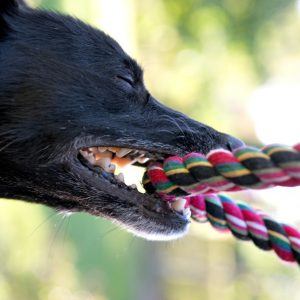“This post contains affiliate links, and I will be compensated if you make a purchase after clicking on my links.”

As dog owners, we are always looking for a way to develop the bond and relationship with our dog. Tug offers us this opportunity while providing other benefits such as: a mental and physical outlet for energy (tug can be played indoors during inclement weather), a chance to practice obedience commands, and a suitable avenue for a dog’s inherent need to bite and chew (potentially preventing destructive behavior in the home).
It is essential that you learn how to play a structured game of tug with your dog. Structured is the operant word. This is NOT simply your dog picking up a random toy and you tugging on it, releasing, and letting your dog run around the house while you chase after to grab the toy. We are playing a game with set rules that both you and the dog understand/follow.
Some people have the misconception that playing tug causes a dog to be aggressive and “dominant”. When it comes to the way we play tug, this is simply not true. If your dog has ever displayed signs of aggression to you or another human, then you should NOT be playing tug with your dog. You should consult with a qualified professional in your area to help you with that issue first. Also make sure your dog does not have a medical condition that would prevent them from safely playing tug. When playing with a young dog, make sure to lower the intensity of the game, as their next and jaw muscles are not fully developed.
Dogs do NOT inherently know how to play any game (tug, fetch or Frisbee). It is our job to teach them the rules. Just as we would not expect a child to know how to play soccer without first teaching it to them, we can’t expect our dog to know how to play a game without teaching them. Below are the basic rules for How to Play a Structured Game of Tug with Your Dog.
- Place dog on a 4’-6’ leash in order to maintain structure/control of the game (i.e. dog should not jump on you, run away, etc.)
- Owner starts game by bringing out tug toy
- Owner tells dog when to engage toy on command (ex. “Get It”)
- Owner instructs dog to release toy on command (ex. “Out”)
- Have the dog perform an obedience command such as “Sit” or “Down” prior to instructing them to re-engage the toy by saying “Get It”
- Repeat steps 3-5 until desired time is up
- On the final “Out” command, reward the dog with a treat and put the tug toy away until next game
Tug is mentally and physically fatiguing for dogs, so it should be played in short intervals (5mins or less) and gradually built up over time. Make sure to end the game on your terms, with the dog wanting more. If you play too long, the dog will lose interest and wander away. It is essential that the dog does not have access to the toy except when you are actively playing with them. This helps to ensure that the dog views the toy as a novelty and wants to play when you bring the toy out. If they have access to the toy all day, they may be bored with it and not want to play when you have time and want to play with your dog.
Playing tug in a structured way offers us the opportunity to strengthen the bond/relationship with our dog, reinforce obedience commands, relieve pent up energy, and provides an appropriate outlet for their inherent genetic needs.
Steve Reid is a certified dog trainer and owner of S.R. Dog Training in Somers, NY. For more information about S. R. Dog Training, visit www.srdogtraining.com or www.facebook.com/SRDogTraining

















